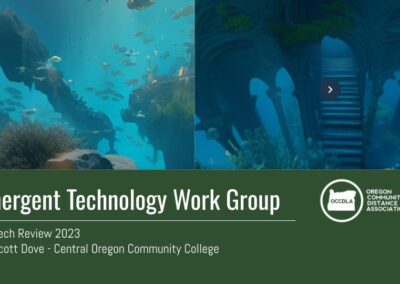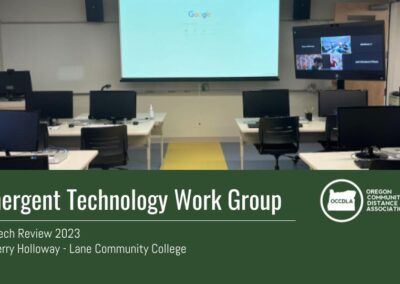EMERGENT TECHNOLOGY WORK GROUP - ED TECH REVIEWS
VR as a Multimodal Composition Practice
by Kevin Smith
Instructor of Journalism, Film Arts, and Writing
Chemeketa Community College
June 24th, 2019
Project Description
The English Program at Chemeketa Community College is exploring how best to integrate multimodal rhetoric into WR 115, 121, 122, and 227 courses. Multimodal composition assignments are currently being encouraged (or required) by state (OWEAC) and national (WPA) professional organizations that oversee writing curriculum. Given that these courses are required of every student seeking a BA, the project is scalable to the highest levels. I propose to incorporate the teaching of VR as a multimodal composition practice, demonstrating how the course outcomes of traditional alphanumeric rhetoric can be shifted into other genres and modes. This project will begin with classroom instruction and then expand to the instruction of full-time and part-time faculty in the program so that they can determine ways in which they can incorporate multimodality into their courses. I would also use these technologies in my journalism courses (JNL 215, 216, and 240) and outside of the classroom in support of the student-run media platforms (Chemeketa Courier) for the college. I am seeking funds for a modest set of VR cameras and viewing equipment to facilitate the involvement of as many students in each class as possible.
Technologies
- VR Headset KAMLE Virtual Reality Headset – 5 -189.95
- LG G5 Friends 360 CAM LG-R105 – 5 – 380.80
- Moto 360 Camera – White – 1 – 179.99
Project Implementation
This project was tested in a Fall 2018 section of WR 121 on Chemeketa’s Salem campus. The total enrollment was 18 by the end of the term, of which 16 participated in the project.Students were randomly placed in groups of four. This project came at the end of the term after substantial instruction in composition, including multimodal composition such as video, audio and infographics, and was a complement to their final text-based research essays. Because this was a pilot project and there wasn’t time to devote an entire term to specific instruction in the relevant technologies, students were awarded pass/fail grades based on whether or not they participated. There was only one student whose group members reported did not participate.
Stages
- Students were given the 360 cameras and VR headsets/controllers and asked to prepare a brief report on their previous experience with the technologies. After 45 minutes of small-group discussion, each group presented said report to the class. All of the groups were vaguely aware of VR technologies, especially through Facebook 360. One group knew about YouTube 360, two individuals had some experience with VR gaming, and one student had seen New York Times VR videos. Overall, the level of knowledge of how the technology could be used to engage in multimodal composition was low. Students were positioned more as consumers and seemed intimidated by the assignment, which was to produce a short VR video embodying the course theme of the tragedy of the commons.
- Students were given three weeks to develop ideas and begin production. Time was devoted during each class session (approximately 30 minutes) for me to check in with each group, assess their progress, answer questions about production and post-production strategies and resources (video and audio editing software), and provide guidance on representing the course/project theme. About halfway through the project, I showed the students two short VR videos I had produced with the Moto Mod 360 camera. These videos did not embody the assigned theme, as I did not want to unduly influence the students’ own individual ideas.
- Students had to turn in their videos or links to such by Finals Week.
Results
Three groups produced conventional videos shot from a single angle and reflecting conventional television/film style that could be viewed in standard digital video playing software. One group produced a video that successfully exploited the capabilities of the VR camera and could best be viewed in the VR headset. All projects did succeed in embodying the theme under consideration. No groups had any issues with post-production (editing, audio, etc.).
Conclusion and Next Steps
Students have little experience with VR technologies beyond commercial gaming. My overall inference was that they felt that VR was not something they were qualified to work with or produce, but instead simply consume. Many of them became aware of the Vive and Oculus through their background research during the project and expressed interest in finding out more about these technologies, but, again, only as consumers. I’ve had solid success in teaching conventional video production in my multimedia journalism courses and would likely stick to this model if I want to continue to incorporate a similar mode in my future writing courses. There doesn’t seem to be enough time to spend teaching about VR, both its uses and specific production practices, in a standard 10-week term while also meeting all other course outcomes. Journalism also seems to be a subject where students seem more engaged in producing content rather than just consuming it. Perhaps it’s something inherent in the curriculum.
Given this experience and a previous one where I briefly explored VR use, I don’t plan on using these technologies in the near future in my writing courses. I may introduce them in my journalism courses, but I will likely stick with conventional video production in multimodal production courses. If the cost barriers for high-end headsets and skill barriers for producing high-quality content come down, I will likely reconsider this stance. At this point in time, I don’t feel that average WR 121 students are ready to successfully use VR technologies in the classroom.
2021-23 ED TECH REVIEWS
TECHNOLOGY EXPLORATION
Do you have an emergent technology you would like to explore? Submit your nomination for a technology evaluation by the OCCDLA Emergent Technology Workgroup.
The OCCDLA Emergent Tech Work Group receives nominations for instructional technology review from work group members and our nomination form, available to all instructors and administrative staff of all Oregon Community Colleges.
Questions?
For questions about the Emergent Technology Work Group:
Administrative Contact:
Monica Marlo
Portland Community College
monica.martinezgallagher@pcc.edu



